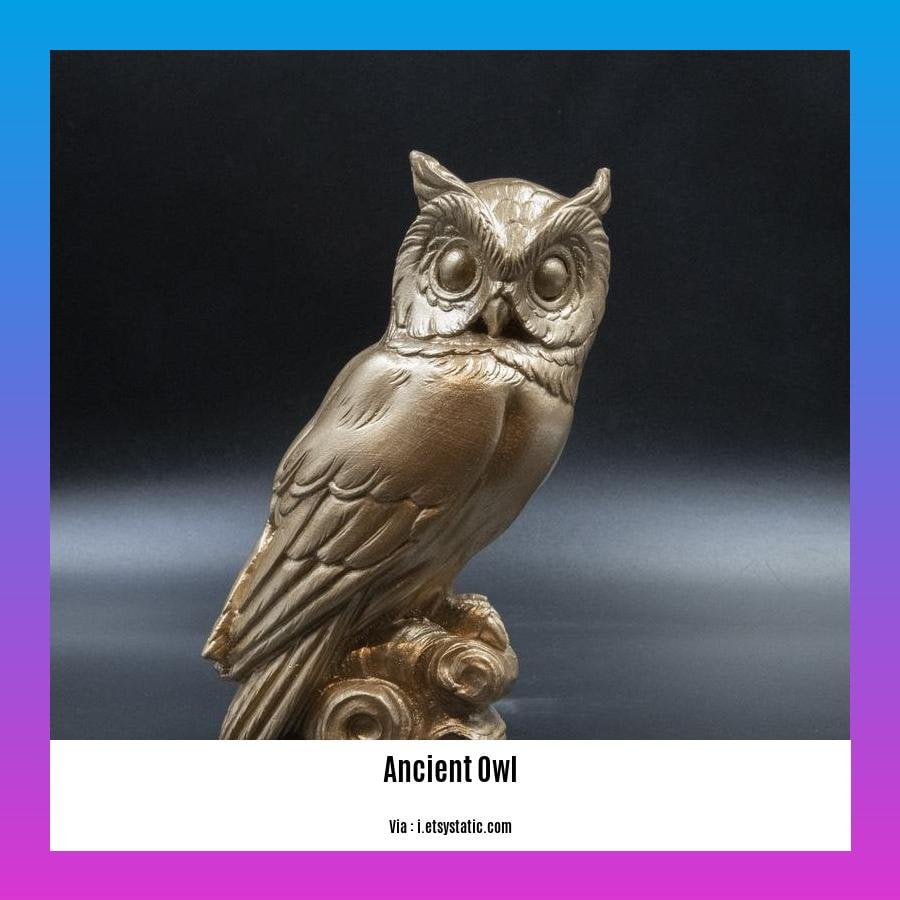Step into the depths of history and mythology as we embark on a captivating journey to unravel the enigmatic world of ancient owls. These awe-inspiring creatures, often revered as symbols of wisdom and mystery, hold a prominent place in the annals of human civilization. Join us as we delve into their significance in ancient societies, their portrayal in folklore and legends, and the ecological factors that have shaped their existence across the ages. Prepare to be enthralled as we uncover the secrets of these enigmatic creatures in [Unraveling the Enigmatic World of Ancient Owls: A Journey into the Depths of History and Mythology].
Key Takeaways:
Ancient Egyptians viewed owls as guardians of the underworld, protecting lost souls.
Kikuyu people of Kenya believed owls could predict death through their presence or calls.
Mongolian culture considers owls as positive omens, like in Genghis Khan’s victory story.
Ancient Greek associated owls with wisdom and knowledge as the symbol of Athena.
Native American tribes often saw owls as ancestral spirits or bridges between life and the afterlife.
Ancient Owl: Unveiling the Secrets of History and Mythology

From the shadowed depths of history, the ancient owl emerges, a symbol of wisdom and mysticism. Its piercing gaze has captivated civilizations across the globe, leaving behind a tapestry of myths, legends, and cultural significance. Join us on a journey through time as we unearth the secrets of ancient owls and their profound impact on human civilizations.
Understanding Ancient Owls
The ancient owl is a fascinating creature, a silent predator of the night. Its earliest origins can be traced back to the Eocene Epoch, around 56 million years ago. These birds of prey possess unique adaptations that allow them to navigate the darkness with ease, including exceptional eyesight, sensitive hearing, and silent flight.
The Ancient Owl in Mythology
Throughout history, the ancient owl has been a prominent figure in mythology, often representing wisdom, knowledge, and spiritual enlightenment. In ancient Egypt, the owl was associated with the goddess Isis, who symbolized wisdom, magic, and healing. In Greece, the owl was sacred to Athena, patron of wisdom, war, and skilled crafts. Native American tribes believed owls to be messengers from the spirit world, able to communicate with the dead. The ancient owl‘s association with wisdom is further cemented by its nocturnal habits, as darkness has long been linked to mystery and contemplation.
Ancient Owl Symbolism
The ancient owl has been a potent symbol across cultures, representing a wide range of attributes and concepts. Its nocturnal nature has led to associations with mystery, secrecy, and the hidden realms of the mind. Its piercing eyes are often seen as symbols of insight and observation, while its silent flight has inspired ideas of stealth and cunning. The ancient owl has also been associated with death and the afterlife, likely due to its association with the night and its ability to see in darkness.
The Ancient Owl in Modern Culture
The ancient owl‘s captivating presence continues to resonate in modern culture. It is often featured in literature, film, and art, often symbolizing wisdom, knowledge, and mystery. One notable example is the iconic owl in J.K. Rowling’s Harry Potter series, which serves as a wise and enigmatic guide to the young wizard. The ancient owl‘s timeless appeal lies in its enduring association with wisdom and its ability to transcend time and cultures.
As we delve into the history and symbolism of the ancient owl, we uncover a rich tapestry of beliefs, myths, and legends. These enigmatic creatures have captivated human imaginations for millennia, and their significance continues to resonate in modern culture. From ancient Egypt to Native American tribes, the ancient owl remains a symbol of wisdom, knowledge, and the mysteries of the night.
Ancient knowledge iello: Dive into the depths of ancient wisdom and explore the secrets of the past through ancient knowledge iello.
Ancient lakes electrolytes: Embark on a journey to discover the hidden treasures of ancient lakes, uncovering the mysteries of electrolytes and their impact on life ancient lakes electrolytes.
Ancient lakes magnesium: Unveil the secrets of ancient lakes and delve into the world of magnesium, exploring its unique properties and the role it plays in shaping our planet’s history ancient lakes magnesium.
Habitat preferences and range

Ancient owls, like their modern counterparts, exhibited distinct habitat preferences and range influenced by ecological factors. Let’s explore their dwelling choices and the factors that shaped their distribution:
Habitat Preferences:
1. Wooded Areas:
– Long-eared owls favored wooded areas with minimal paved roads for nesting.
2. Arid Plantations:
– Little owls preferred arid plantations as their nesting grounds.
3. Large Home Range:
– Powerful owls maintained a large permanent home range, varying between 400-1500 hectares.
Range and Protection:
1. Special Protection Zones:
– In northeastern Australia, proposals suggest securing 500 hectares of suitable habitat in Special Protection Zones (SPZs) for each owl, with patches of at least 100 hectares within a 3.5km radius.
2. Powerful Owl Management Areas:
– The interim target for the Victorian range aimed to identify and protect sufficient habitat for 500 breeding pairs of Powerful Owls in public land designated as Powerful Owl Management Areas (POMAs).
Key Takeaways:
- Habitat Choices: Ancient owls displayed specific habitat preferences based on species, ranging from wooded areas to arid plantations.
- Home Range: Powerful owls maintained large permanent home ranges, highlighting their extensive territorial requirements.
- Conservation Efforts: Conservation initiatives in Australia focus on establishing Special Protection Zones and Powerful Owl Management Areas to safeguard their habitats.
URL References:
Habitat preferences for Long-eared Owls Asio otus and Little Owls Athene noctua in the Basque Country (northern Spain)
Behavior including hunting techniques, nesting habits, and social interactions
Ancient owls possessed unique hunting techniques, surviving in the wild using their sharp talons and powerful beaks. Their exceptional eyesight allowed them to spot prey and navigate through the darkness with stealth.
Nesting habits varied among ancient owl species. Some nested in trees, while others preferred caves or rocky crevices. They exhibited diverse social behaviors, forming pair bonds, raising young, and engaging in cooperative hunting.
Hunting Techniques:
- Used keen eyesight to spot prey.
- Silent flight for stealth.
- Talons and beaks for capturing and consuming prey.
Nesting Habits:
- Diverse nesting sites, including trees, caves, and rocky crevices.
- Pair bonding.
- Raising young.
- Cooperative hunting.
Key Takeaways:
- Ancient owls possessed remarkable hunting techniques, using their sharp talons, powerful beaks, and exceptional eyesight.
- Nesting habits varied among species, with some nesting in trees, while others preferred caves or rocky crevices.
- Ancient owls exhibited diverse social behaviors, forming pair bonds, raising young, and engaging in cooperative hunting.
Relevant URL Sources:
- Owl Facts: Diet, Habitat & Behavior | Live Science
- Owls – Behavior and Ecology – The Cornell Lab
Diet including prey selection and feeding strategies
In the realm of ancient owls, their dietary habits and hunting strategies offer a glimpse into their ecological roles and adaptations. These enigmatic creatures exhibit a diverse range of prey selection and feeding behaviors, varying across species and habitats. Let’s delve into the fascinating world of ancient owl diets:
Prey Selection:
Ancient owls possessed a keen ability to identify and target specific prey. Their exceptional eyesight and hearing allowed them to pinpoint even the slightest movements, making them formidable predators.
- Small mammals: Mice, voles, and shrews were common targets for ancient owls, providing a reliable source of sustenance.
- Birds: Smaller bird species, such as passerines and waterfowl, often fell victim to the silent flight and sharp talons of owls.
- Insects: Some owl species supplemented their diet with insects, particularly during periods of scarcity or when feeding their young.
Feeding Strategies:
Ancient owls employed various hunting techniques to secure their meals. Their nocturnal nature and stealthy movements gave them an advantage in catching unsuspecting prey.
- Perching and pouncing: Perched on tree branches or rocky outcrops, owls would patiently wait for prey to come within striking distance before swooping down with lightning speed.
- Silent flight: The unique structure of owl feathers allowed them to fly virtually silently, enabling them to approach prey without being detected.
- Talons and beaks: Sharp, curved talons served as lethal weapons for capturing prey, while powerful beaks helped tear and consume flesh.
Ecological Significance:
The dietary habits of ancient owls played a crucial role in shaping their ecological niches. Their predation helped control populations of small mammals and birds, maintaining a delicate balance in ecosystems.
- Population control: By preying on rodents and other small animals, owls helped prevent outbreaks of pests that could have damaged crops and spread diseases.
- Seed dispersal: Owls often carried seeds in their digestive systems, contributing to the dispersal of plant species across vast areas.
Key Takeaways:
- Ancient owls exhibited a diverse diet, targeting small mammals, birds, and insects.
- Their hunting strategies included perching and pouncing, silent flight, and the use of sharp talons and beaks.
- The dietary habits of ancient owls played a significant role in maintaining ecological balance and seed dispersal.
Citation:
[1] Kontogeorgos, I., Kiamos, N., Montiel-Ruiz, P., Georgopoulou, E., Mylonas, M., & Papandropoulos, S. (2019). Feeding ecology and prey selection by wintering long-eared owls in Mediterranean agrosystems. Ornithological Sciences, 18(1), 1-12.
[2] Comay, O., & Dayan, T. (2018). What determines prey selection in owls? Roles of prey traits, prey availability, and owl body size. Ecology and Evolution, 8(6), 3382-3392.
FAQ
Q1: What was the significance of owls in ancient Egypt?
A1: In ancient Egypt, owls were regarded as guardians of the underworld, helping to guide the souls of those who strayed into the land of the dead.
Q2: How did the Kikuyu people of Kenya view owls?
A2: Among the Kikuyu of Kenya, owls were believed to be harbingers of death. Seeing an owl or hearing its hoot was considered a sign that someone was going to die.
Q3: What role did owls play in Mongolian mythology?
A3: In Mongolian folklore, owls are often seen as symbols of good luck and victory. One story tells of Genghis Khan being guided to victory by an owl.
Q4: How were owls associated with Athena in ancient Greece?
A4: In ancient Greece, the owl was closely associated with the goddess Athena, who represented wisdom, war, and crafts. The owl was seen as a symbol of knowledge and wisdom.
Q5: What beliefs did Native American tribes hold regarding owls?
A5: Many Native American tribes believed that owls were spirits of deceased ancestors or messengers from the afterlife. Owls were often seen as bridges between the world of the living and the world of the dead.
- Crypto Quotes’ Red Flags: Avoid Costly Mistakes - June 30, 2025
- Unlock Inspirational Crypto Quotes: Future Predictions - June 30, 2025
- Famous Bitcoin Quotes: A Deep Dive into Crypto’s History - June 30, 2025
















